|
©Copyright
1997-2010
Johnson
Kinetics, Inc.
All
Rights Reserved
Pages
best printed
in
Landscape
|
|
ElectroStimulation Research
and Products
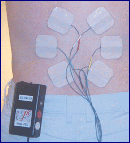 Electrostimulation
( or Electronic Nerve Stimulation ) is the process of using electrical
waveforms to create a variety of sensations on the skin and in surrounding
tissue. It is the fundamental science behind TENS, nerve stimulation,
electrotactile, Functional Nerve Stimulators (FES), Neuro-Muscular Disrupters
and other fields. Electrostimulation
( or Electronic Nerve Stimulation ) is the process of using electrical
waveforms to create a variety of sensations on the skin and in surrounding
tissue. It is the fundamental science behind TENS, nerve stimulation,
electrotactile, Functional Nerve Stimulators (FES), Neuro-Muscular Disrupters
and other fields.
JKI maintains an active R&D program
in Electro-Stimulation for biofeedback, pain alleviation, and ElectroTactile
Stimulation. We provide custom devices, experimental systems, test-bed
platforms, incorporation of technologies for third-party products / research,
and perform on-going clinical developments.
Current Research
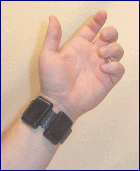 JKI
has over 8 years research in Electro-Stimulation. Our research efforts
and programs are in cooperation with the Air Force Research Laboratory,
Wright-Patterson AFB, OH and the Dayton VA Hospital. These efforts
have lead to new theories of Electronic Pain Alleviation, subsequent products
and development efforts. Our work is both empirical and product oriented
as several technologies have been successfully integrated into medical,
commercial, and experimental, and stand-alone products. JKI
has over 8 years research in Electro-Stimulation. Our research efforts
and programs are in cooperation with the Air Force Research Laboratory,
Wright-Patterson AFB, OH and the Dayton VA Hospital. These efforts
have lead to new theories of Electronic Pain Alleviation, subsequent products
and development efforts. Our work is both empirical and product oriented
as several technologies have been successfully integrated into medical,
commercial, and experimental, and stand-alone products.
TENS / PES Products
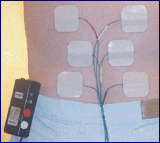 Traditional
TENS (Transcutaneous Electric Nerve Stimulators) devices are only good
for 50% of the population and become accommodated typically within two
hours of use. The users are forced to play with settings and gradually
increase the amplitude. Often bothered by muscle stimulation and secondary
pain. Our research into heavy user chronic pain alleviation focused
on three product development goals: Traditional
TENS (Transcutaneous Electric Nerve Stimulators) devices are only good
for 50% of the population and become accommodated typically within two
hours of use. The users are forced to play with settings and gradually
increase the amplitude. Often bothered by muscle stimulation and secondary
pain. Our research into heavy user chronic pain alleviation focused
on three product development goals:
-
Increased Intensity--More power transfer in helpful
and safe ways without wasting battery life
-
Anti-Accomodation Measures--Longer effective relief
over time and across settings and users
-
Fewer Side-Effects--Decreased muscle stimulation,
induced 'pin-pricks' sensation or heat built up.
The result is a series of improved technologies and
methodologies culminating in our PES (Polarizing Electronic Stimulator)
series of High Power Units ( PES-I, Mega-PES ) built for moderate and heavy
use for both chronic and acute pain. Applying numerous next technologies
in one unit allows a wide range of features which has shown increased results
in patient populations in clinical trials.
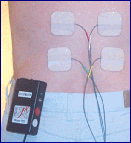 JKI
Currently provides Custom PES, Mega-PES, and similar units to clients and
is seeking partnerships the technology to carry forward to larger markets. JKI
Currently provides Custom PES, Mega-PES, and similar units to clients and
is seeking partnerships the technology to carry forward to larger markets.
One of the advantages of Mega-PES devices is the
number of electrodes and functional combinations of arrangements depending
on the user's needs. We provide 4, 6, and 8 channel outputs that
all work together to provide the widest available stimulation patterns.
Electro-Stimulation for directed application has many advantages as it
can be focused to pain or injury sites.
Technologies
 Years
of research has produced a variety of proprietary technologies and methods
that are vast improvements over current techniques. Many of these
are incorporated into current products and /or available for license.
Some of these proprietary developments include: Years
of research has produced a variety of proprietary technologies and methods
that are vast improvements over current techniques. Many of these
are incorporated into current products and /or available for license.
Some of these proprietary developments include:
-
Tri-Polar Electrode Driver Stage
-
Spatial, Temporal, Impedance, and Sensation Randomness
Patterns
-
Proprietary Waveform and Discrete Waveform Shaping
-
Pulsed Power Conversion
-
Impedance Matched Stimulation
-
Active Accommodation Methods
-
Pain Profiling Matrix Analysis
E-Tactor Systems
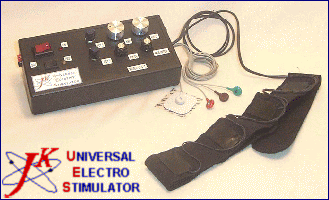 The
opposite focus in applying gentile and soothing pulse trains are those
that are designed to get your attention. Electro-Stimulation as a
Tactile input offers numerous advantages are identified with our proprietary
ETS Systems to traditional motor, heat, vibration, or pneumatic driven
systems including less weight, higher concentrations of ETS Tactors, more
versatile stimulation functions ( current pathway, amplitude, frequency,
pulse duty cycle, waveform, etc. ). ETS systems operate a much higher speed
to create complex sensations like wiggle, spin, race, wobble, radiating,
direction and decay. The
opposite focus in applying gentile and soothing pulse trains are those
that are designed to get your attention. Electro-Stimulation as a
Tactile input offers numerous advantages are identified with our proprietary
ETS Systems to traditional motor, heat, vibration, or pneumatic driven
systems including less weight, higher concentrations of ETS Tactors, more
versatile stimulation functions ( current pathway, amplitude, frequency,
pulse duty cycle, waveform, etc. ). ETS systems operate a much higher speed
to create complex sensations like wiggle, spin, race, wobble, radiating,
direction and decay.
To foster internal research and external interest,
we have built several working test platforms. The first prototype
series, shown here, various models of Universal Electro-Stimulators have
provided experimental and development data and response for numerous programs.
The latest in ETS systems are detailed in our ElectroTactile Stimulation
Section of this site.
Touch Mapping
A great substitute for heavily tasked visual or
auditory inputs, tactile feedback is becoming more popular for a variety
of applications to communicate information. Arrays of E-Tactor electrodes
form grids, belts, or other garments which can be mapped to internal or
external coordinate systems, vectors, or points of reference. Mapping
can also be used for discrete functions warning systems, communication
channels with appropriate placement.
Gait Correction Applications
Our RunningMate Line of devices measures
and records distributed pressures in an instrumented shoe's insole.
In addition to data collection, a closed loop scenario can be established
linking pressure readings to E-Tactor output patterns. RunningMate
instrumented insoles form a Center-of-Pressure indicator and means of correction
for bad placements and gait patterns. Critical with persons with
decreased nerve sensation or injury are the sensations felt by the feet.
E-Tactor based balance devices augment this sensation and can also be tied
to audible alarms as well as electro-tactile stimulation.
//
|
|





